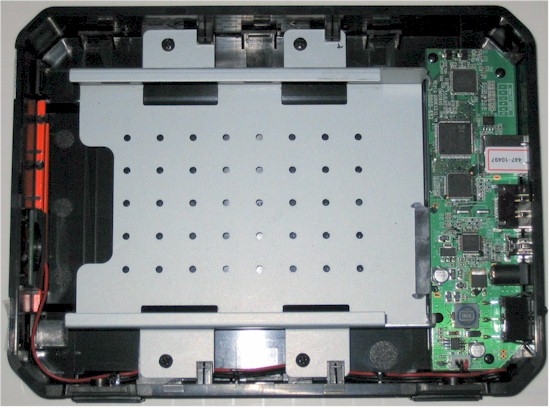Introduction
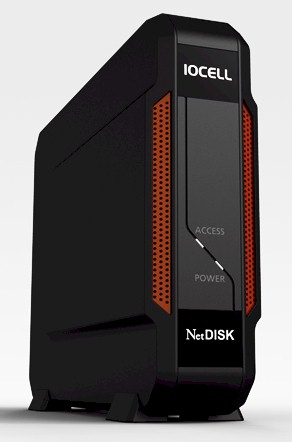
| At a Glance | |
|---|---|
| Product | IOCELL NetDISK (351UNE) |
| Summary | Speedy, inexpensive SATA enclosure that connects via Ethernet, USB or eSATA based on Ximeta NDAS technology. |
| Pros | • Connects via Ethernet, USB or eSATA • ~30 MB/s file copy in network mode • Good price vs. performance |
| Cons | • It just does storage, no media serving, etc. • Linux support is beta and requires compiling |
Many moons ago (September 2003, to be exact), I reviewed a storage product that advertised itself as a cheaper alternative to NAS. Ximeta‘s original NetDisk was an 3.5″ IDE drive enclosure with USB and Ethernet ports that could either attach directly to your computer or sit on an Ethernet LAN through the magic of Ximeta’s NDAS (Network Direct Attached Storage) technology.
The catch was that, unlike conventional NASes, you needed to install software on your computer to use it and write access was limited to one user at a time. When a user wanted to write to the disk, the software automatically moved write access for the drive, with only a beep to let the current owner of write privileges know that he or she was no longer in charge.
Although drivers were available for Win 93SE, ME, CE XP and 2000 as well as Mac OS X and Red Hat, multi-user write was available only to Win XP / 2000 users. NDAS mode was actually slower than USB 2.0 and its $50 or so cost premium over an equivalent capacity USB 2.0 external drive caused me to lose interest pretty quickly.
I liked the Office version that Ximeta introduced about 6 months later a bit better, noting that it had a price and performance advantage over conventional NASes of the time. But multiple user write support was still a bit odd and limited only to Windows XP and 2000 users.
Flash forward to this past summer when a press release landed in my inbox announcing an “innovative external network storage drive” that sported Ethernet, USB2.0 and eSATA ports and used Ximeta’s NDAS. Although I thought I’d seen this movie before, its claims of being able to aggregate up to 8 drives into one logical spanned or RAID 0 volume and two drives into a RAID 1 array intrigued me.
So I asked for two review units with drives to see how Ximeta’s technology had progressed and to check out the multi-unit claims. But it took until just a few weeks ago for one 351UNE to show up, without a drive installed. Oh well, let’s see what this little guy can do anyway.
The UNE is about as tall, but slightly thinner than a typical single-drive NAS. The case is all plastic and has no cooling fan. Figure 1 shows the rear panel, which has Gigabit Ethernet, eSATA and mini-USB ports. There’s also a socket for the 12V power wall-wart and a power switch. IOCELL includes cables for all three port types in the box.
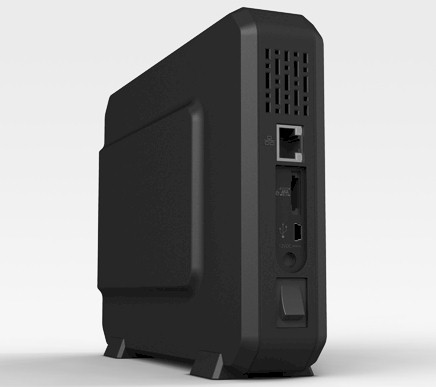
Figure 1: Back of the UNE
Inside Look
Figure 2 shows the inside of the UNE, once you remove two screws and slide off the cover. It’s a bit of a pain to have to remove the metal drive holder in order to insert the drive. It also seemed like you’d better not be taking out the sleeve too many times or you’ll strip the plastic posts that you screw the holder down onto.
Figure 2: NetDisk 351UNE inside
Given the UNE’s unusual design, I figured that I wouldn’t see the usual suspects for its components and I was right. The main controller chip is a Ximeta NDAS3012GR2, which has a Gigabit Ethernet interface, can support two drives and up to 64 simultaneous users. There is no evidence of jumbo frame support in the NDAS utility, but you’ll see that the UNE is pretty peppy without it.
Other components include a Jmicron JM20330 SATA 1.5 GHpb bridge, LSI ET1011C2 Gigabit Ethernet Transceiver and Initio INIC-1611 SATA USB bridge. I couldn’t find any RAM or flash on the board.
Power draw isn’t bad, only 15 W with a Seagate ST31000333AS Barracuda 7200.11 1 TB drive spun up. I was pleased to find there’s a non-programmable idle drive spindown (seems like 15 minutes or so) that knocked power draw down to around 8 W.
Setup
The only documentation you get is a printed User’s Manual, which is really just a quick setup guide. The same thing comes on the supplied CD, which also contains the drivers, utility program and some other programs from partner 2BrightSparks, including 30 day trials of SyncBack Pro and SyncBack SE backup programs.
So I checked the support area of the IOCELL site and found real user manuals for Windows, Mac OS Tiger, Leopard and Panther. I also found and a more recent Windows driver installation package than was on the CD (NDAS 3.71), which I used for my testing.
The download area also had downloads for Mac OS 10.6 Snow Leopard (Beta) as well as Tiger and Leopard. If you want Linux drivers, you need to hit Ximeta’s site, where you’ll find that “NDAS Software for Linux is currently in beta status”. I guess some things haven’t changed since 2003!
Once you have the UNE plugged in via the desired port, you just run the installation file. At some point in the process you’ll need to register the drive (Figure 3) by entering information you’ll find on the label on the bottom of the UNE.
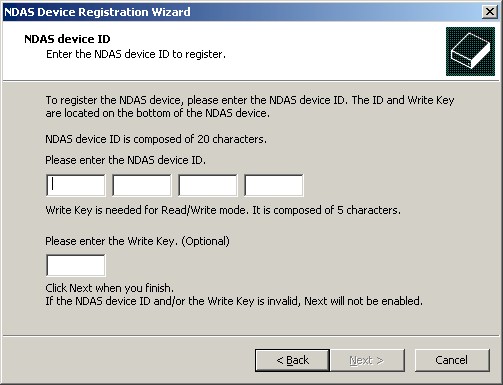
Figure 3: Device registration screen
If you installed an unformatted drive, you’ll need to use the host systems disk management utilities to format the drive. I used Windows Disk Manager and ran a quick NTFS format.
When you’re done, you’ll have a little device management utility running in the Windows tray / notification area. You use this to check the drive’s status, register / de-register drives and mount and dismount drives. When you mount, you can mount read only or with read/write privileges.
How It Works
When the drive is mounted, it appears as a local drive, not as a network drive. If you check Device Manager, you’ll see it as a SCSI drive. Figure 4, taken from a whitepaper published in the May 2005 IEEE Communications Magazine, shows a high-level comparison of traditional NAS and Ximeta’s NDAS architectures.
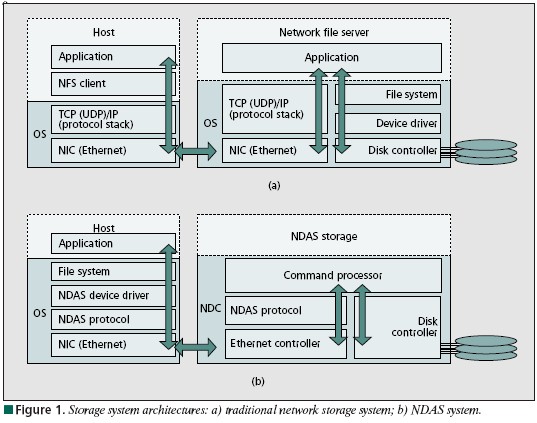
Figure 4: NDAS vs. NAS
A key difference is that NDAS doesn’t have the TCP/IP overhead that NASes have, so can produce higher performance with simpler (and much less expensive hardware). This page has a simplified architecture comparison diagram and a point-by-point comparison table.
If you’re thinkin’ this sorta smells like iSCSI, it’s not. While iSCSI makes part of a networked NAS appear as local storage, that portion is dedicated to the computer that connects to it.
With NDAS, the storage that sits on the LAN also appears as a local drive, but that drive can also be shared by other (up to 64) users. Each user, however, must have the NDAS drivers and utility installed, however.
But once the drivers and installed and the drive mounted, it acts just like any other mapped network drive…except it’s significantly faster without the overhead of TCP/IP! I verified this by installing the driver on Vista SP1 and XP SP3 systems and was able to simultaneously copy files from both machines to the UNE.
Performance
I installed a Seagate ST31000333AS Barracuda 7200.11 1 TB drive to check out the UNE and ran the standard Vista SP1 filecopy test, which copies a 4.35 GB ripped DVD test folder from a RAID 0 volume on our standard NAS testbed to and from the NAS under test. As mentioned earlier, the disk was NTFS formatted.
Figure 5 shows a composite plot of the results with USB 2.0, eSATA and NDAS (Gigabit Ethernet) connections to the host system.
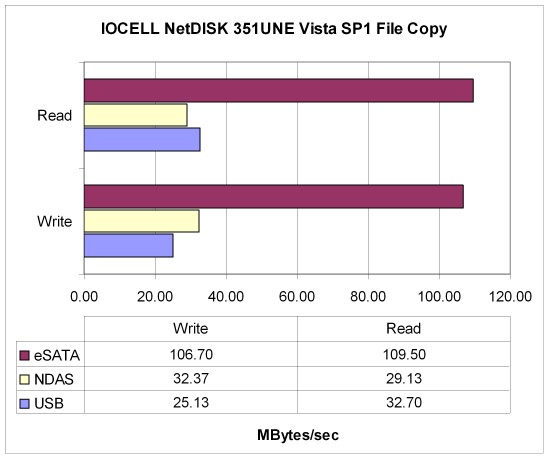
Figure 5: UNE Vista SP1 Filecopy performance
The eSATA connection naturally has the highest performance, actually quite high compared even to the Iomega Ultramax Pro, which measured around 96 MB/s writing to a two-drive RAID 0 volume and 83 MB/s reading. USB 2.0 results indicated pretty much the maximum possible from that connection.
NDAS write at 32 MB/s was better than USB, but not quite as good for read. But at around 30 MB/s for write and read over a Gigabit Ethernet connection for a $70 drive enclosure, that’s not bad at all.
I have been skipping iozone tests for devices like the CTERA CloudPlug and Seagate FreeAgent Dockstar because I don’t consider them to be "real" NASes. But I decided to run them anyway for the UNE.
Figure 6 shows that the iozone based plots are dominated by cached performance, as I would expect given NDAS’ nature. But with cached performance taken out and the remaining points averaged, write comes in at 51.2 MB/s and read at 38.5 MB/s. The write results actually rank the UNE at #3 with the NAS Charts filtered for single drive products!
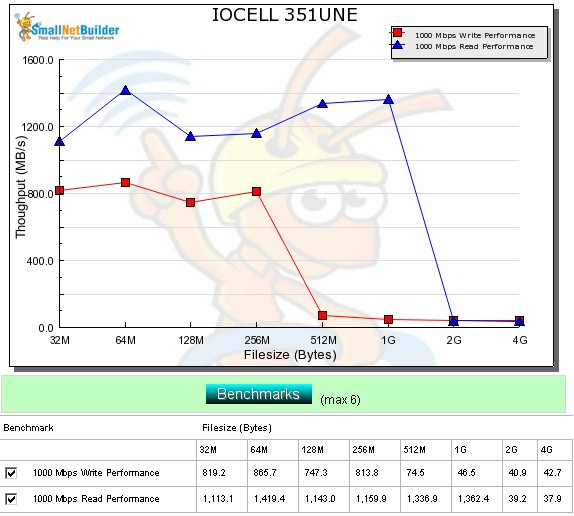
Figure 6: UNE iozone-based performance
A more realistic comparison would be found in the File Copy charts, again filtered for single-drive products. While not at the top of the charts, the UNE beats out current-generation single-drive NASes like the Seagate BlackArmor 110 and WD My Book World Edition (white bar).
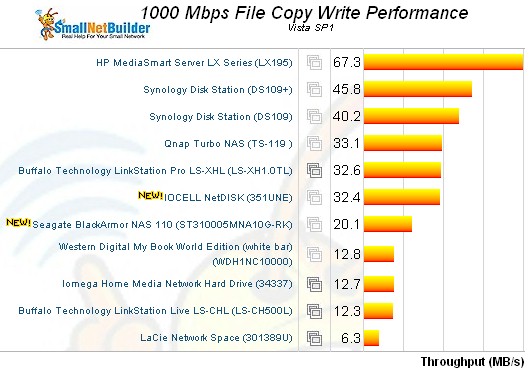
Figure 7: File copy write performance – single drive products
Figure 8 shows the read file copy ranking, where the UNE drops below the WD and Seagate products, however.
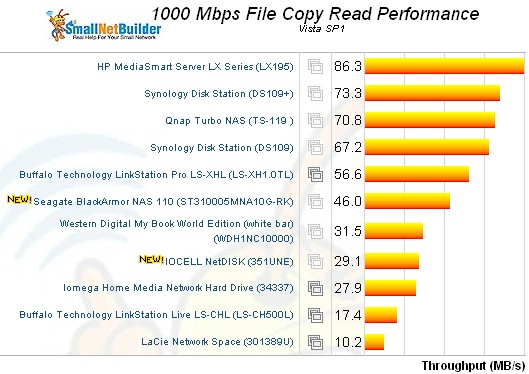
Figure 8: File copy read performance – single drive products
I mentioned earlier that I simultaneously ran file copies to the UNE from Vista SP1 and XP SP3 systems. While the XP system wasn’t as fast as the Vista, I didn’t see any change in file copy speed on the XP system and only a 5 – 10 MB/s drop on the faster Vista system.
Closing Thoughts
I went into this review with a skeptical eye, expecting to see something similar to what I found around six years ago. So I have to say that I’m pleasantly surprised by the NetDisk UNE.
Time and technology advancements have helped IOCELL and Ximeta produce a much more competitive product in both price and performance than the original NetDISK. And, at least with the Windows systems that I used, I found no problem with simultaneously writing to the UNE from two systems.
I didn’t get to check IOCELL’s claims of multi-drive RAID 0 and 1 combining. So perhaps that will have to wait for another time. From the looks of IOCELL’s website, they’re planning two and five bay members of the NDAS line, so I may be taking a look at those, too, when they’re available.
In the meantime, if you’ve been looking for network storage that also can be directly-connected and don’t need it to do anything else (no FTP, print, media, web, photo serving or BitTorrent downloading), for $70 and your own 3.5" SATA drive, the IOCELL NetDisk 351UNE is a pretty good solution.

